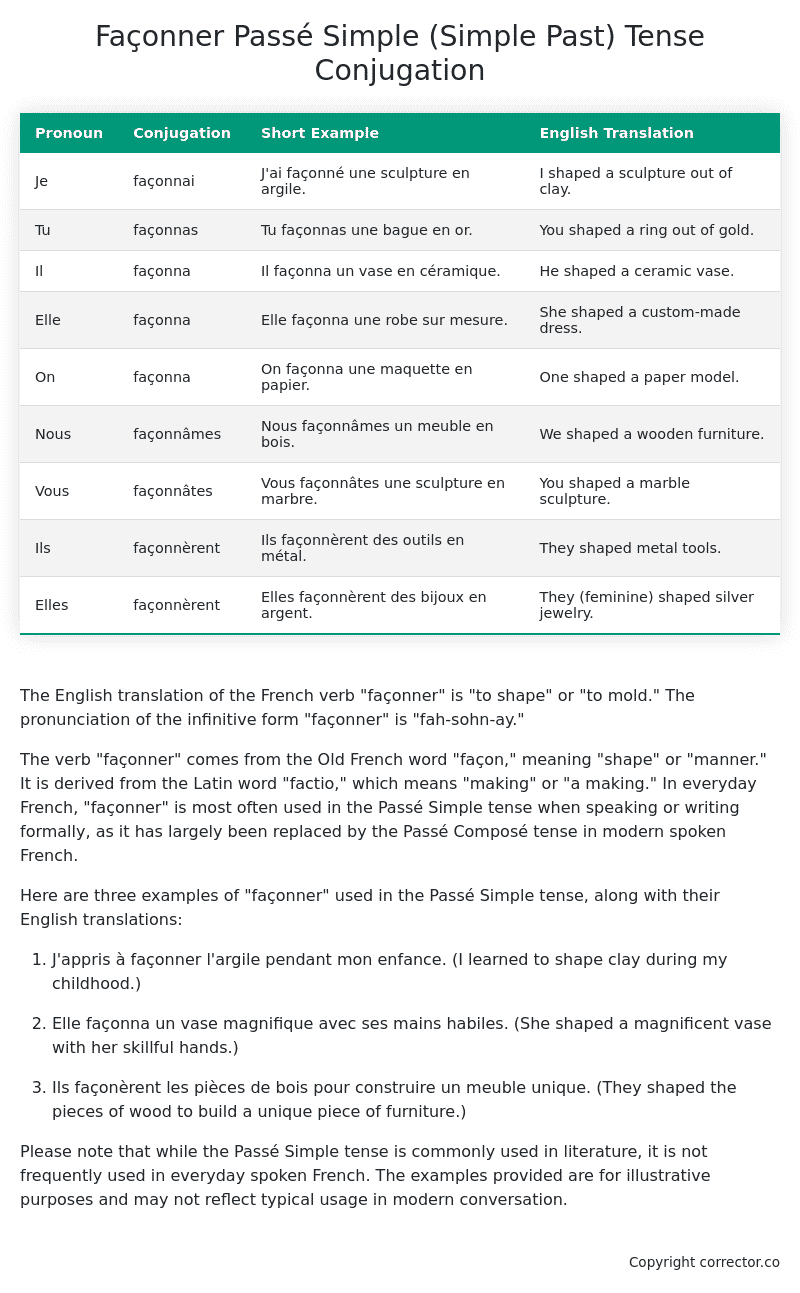Passé Simple (Simple Past) Tense Conjugation of the French Verb façonner
Introduction to the verb façonner
The English translation of the French verb “façonner” is “to shape” or “to mold.” The pronunciation of the infinitive form “façonner” is “fah-sohn-ay.”
The verb “façonner” comes from the Old French word “façon,” meaning “shape” or “manner.” It is derived from the Latin word “factio,” which means “making” or “a making.” In everyday French, “façonner” is most often used in the Passé Simple tense when speaking or writing formally, as it has largely been replaced by the Passé Composé tense in modern spoken French.
Here are three examples of “façonner” used in the Passé Simple tense, along with their English translations:
-
J’appris à façonner l’argile pendant mon enfance.
(I learned to shape clay during my childhood.) -
Elle façonna un vase magnifique avec ses mains habiles.
(She shaped a magnificent vase with her skillful hands.) -
Ils façonèrent les pièces de bois pour construire un meuble unique.
(They shaped the pieces of wood to build a unique piece of furniture.)
Please note that while the Passé Simple tense is commonly used in literature, it is not frequently used in everyday spoken French. The examples provided are for illustrative purposes and may not reflect typical usage in modern conversation.
Table of the Passé Simple (Simple Past) Tense Conjugation of façonner
| Pronoun | Conjugation | Short Example | English Translation |
|---|---|---|---|
| Je | façonnai | J’ai façonné une sculpture en argile. | I shaped a sculpture out of clay. |
| Tu | façonnas | Tu façonnas une bague en or. | You shaped a ring out of gold. |
| Il | façonna | Il façonna un vase en céramique. | He shaped a ceramic vase. |
| Elle | façonna | Elle façonna une robe sur mesure. | She shaped a custom-made dress. |
| On | façonna | On façonna une maquette en papier. | One shaped a paper model. |
| Nous | façonnâmes | Nous façonnâmes un meuble en bois. | We shaped a wooden furniture. |
| Vous | façonnâtes | Vous façonnâtes une sculpture en marbre. | You shaped a marble sculpture. |
| Ils | façonnèrent | Ils façonnèrent des outils en métal. | They shaped metal tools. |
| Elles | façonnèrent | Elles façonnèrent des bijoux en argent. | They (feminine) shaped silver jewelry. |
Other Conjugations for Façonner.
Le Present (Present Tense) Conjugation of the French Verb façonner
Imparfait (Imperfect) Tense Conjugation of the French Verb façonner
Passé Simple (Simple Past) Tense Conjugation of the French Verb façonner (You’re reading it right now!)
Passé Composé (Present Perfect) Tense Conjugation of the French Verb façonner
Futur Simple (Simple Future) Tense Conjugation of the French Verb façonner
Futur Proche (Near Future) Tense Conjugation of the French Verb façonner
Plus-que-parfait (Pluperfect) Tense Conjugation of the French Verb façonner
Passé Antérieur (Past Anterior) Tense Conjugation of the French Verb façonner
Futur Antérieur (Future Anterior) Tense Conjugation of the French Verb façonner
Subjonctif Présent (Subjunctive Present) Tense Conjugation of the French Verb façonner
Subjonctif Passé (Subjunctive Past) Tense Conjugation of the French Verb façonner
Subjonctif Imparfait (Subjunctive Imperfect) Tense Conjugation of the French Verb façonner
Subjonctif Plus-que-parfait (Subjunctive Pluperfect) Tense Conjugation of the French Verb façonner
Conditionnel Présent (Conditional Present) Tense Conjugation of the French Verb façonner
Conditionnel Passé (Conditional Past) Tense Conjugation of the French Verb façonner
Conditionnel Passé II (Conditional Past II) Tense Conjugation of the French Verb façonner
L’impératif Présent (Imperative Present) Tense Conjugation of the French Verb façonner
L’impératif Passé (Imperative Past) Tense Conjugation of the French Verb façonner
L’infinitif Présent (Infinitive Present) Tense Conjugation of the French Verb façonner
L’infinitif Passé (Infinitive Past) Tense Conjugation of the French Verb façonner
Le Participe Présent (Present Participle) Tense Conjugation of the French Verb façonner
Le Participe Passé (Past Participle) Tense Conjugation of the French Verb façonner
Struggling with French verbs or the language in general? Why not use our free French Grammar Checker – no registration required!
Get a FREE Download Study Sheet of this Conjugation 🔥
Simply right click the image below, click “save image” and get your free reference for the façonner Passé Simple tense conjugation!

Façonner – About the French Passé Simple (Simple Past) Tense
Formation
Usage
Narration
Historical Context
Interactions with other tenses
Passé Composé
Imparfait
Conditional and Subjunctive
Summary
I hope you enjoyed this article on the verb façonner. Still in a learning mood? Check out another TOTALLY random French verb conjugation!


